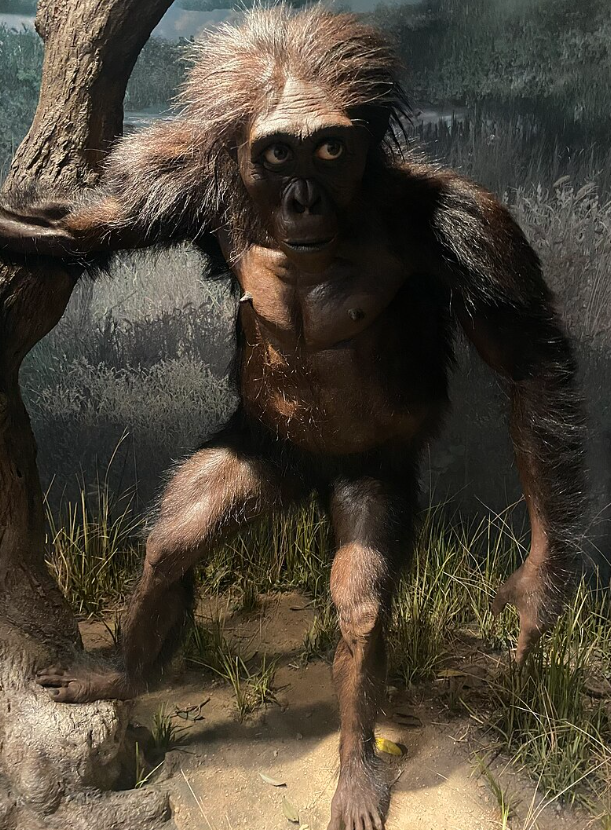
The model of Australopithecus afarensis at the Smithsonian National Museum of Natural History is a fascinating depiction of an early hominin that lived around 3.9 to 2.9 million years ago. This species, which includes the famous specimen “Lucy,” is often portrayed as a key species in understanding human evolution.
In this particular reconstruction, the A. afarensis model is used to illustrate the facultative bipedalism hypothesis. This theory suggests that A. afarensis could walk on two legs (bipedalism) on the ground, but still retained some arboreal (tree-climbing) traits. The model emphasizes that while A. afarensis was capable of walking bipedally, it also likely used the trees for support or stabilization, possibly for feeding, nesting, or escaping predators.
This is indicated by the positioning of the model, which often shows the hominin using a tree or branch for stabilization. Features of the body, like the curvature of the fingers and the structure of the pelvis, suggest that A. afarensis was not exclusively bipedal but instead had a mixed mode of locomotion. While its hips and legs show adaptations for walking on two legs, the longer, curved fingers suggest it still spent time climbing.
This model offers visitors a chance to understand the complexity of early hominin behavior—A. afarensis was not simply a bipedal ground-dweller but may have moved between both the ground and trees depending on the situation. The reconstruction serves as an important visual representation of this aspect of our evolutionary history.
The model of Australopithecus afarensis at the Smithsonian is an important educational tool, as it helps visitors visualize how early hominins like A. afarensis might have looked and moved. In terms of its physical features, this species was relatively small—males were about 4.5 feet tall, while females were shorter, around 3.5 feet. Its body shape shows a combination of traits seen in both primates and later humans.
In addition to its facultative bipedalism, the model highlights the fascinating interplay between features suited for climbing and those for walking on the ground. The body had adaptations for both behaviors. For instance, the pelvis of A. afarensis shows characteristics similar to those of modern humans, allowing for more efficient walking on two legs. The lower limbs, especially the knee joint, were well-suited for bipedal walking, and the foot structure shows signs of arch development, which is important for walking long distances.
However, its arms and hands were still adapted for climbing. The model’s hands and long fingers illustrate these climbing features, as they were better suited for grasping branches than for tool use or other human-like activities. The curvature of the fingers is especially notable, as it suggests that while A. afarensis may have spent a significant amount of time on the ground, it would have likely used trees for various purposes, including feeding on fruit, resting, or escaping predators.
The facial features of A. afarensis also provide insight into its evolution. The face is more prognathous (jutting out) compared to modern humans, with a flatter, more ape-like nose. Its brain size was relatively small, around 400-500 cubic centimeters, which is about the size of a chimpanzee’s brain.
The facultative bipedalism hypothesis emphasizes the transitional nature of this species—it wasn’t fully bipedal like later hominins (such as Homo erectus) but was instead more flexible in its movement patterns. Some researchers believe that this mixed form of locomotion was advantageous in the varied environments of East Africa at the time, where forests were giving way to more open savannas. The ability to move both on the ground and in trees would have provided greater survival options.
This model is crucial because it demonstrates the gradual shift in human evolution from a fully tree-dwelling existence to one increasingly adapted to life on the ground. Understanding the complexities of A. afarensis‘ locomotion helps us better understand the early stages of hominin evolution and how our ancestors adapted to their environments over time.